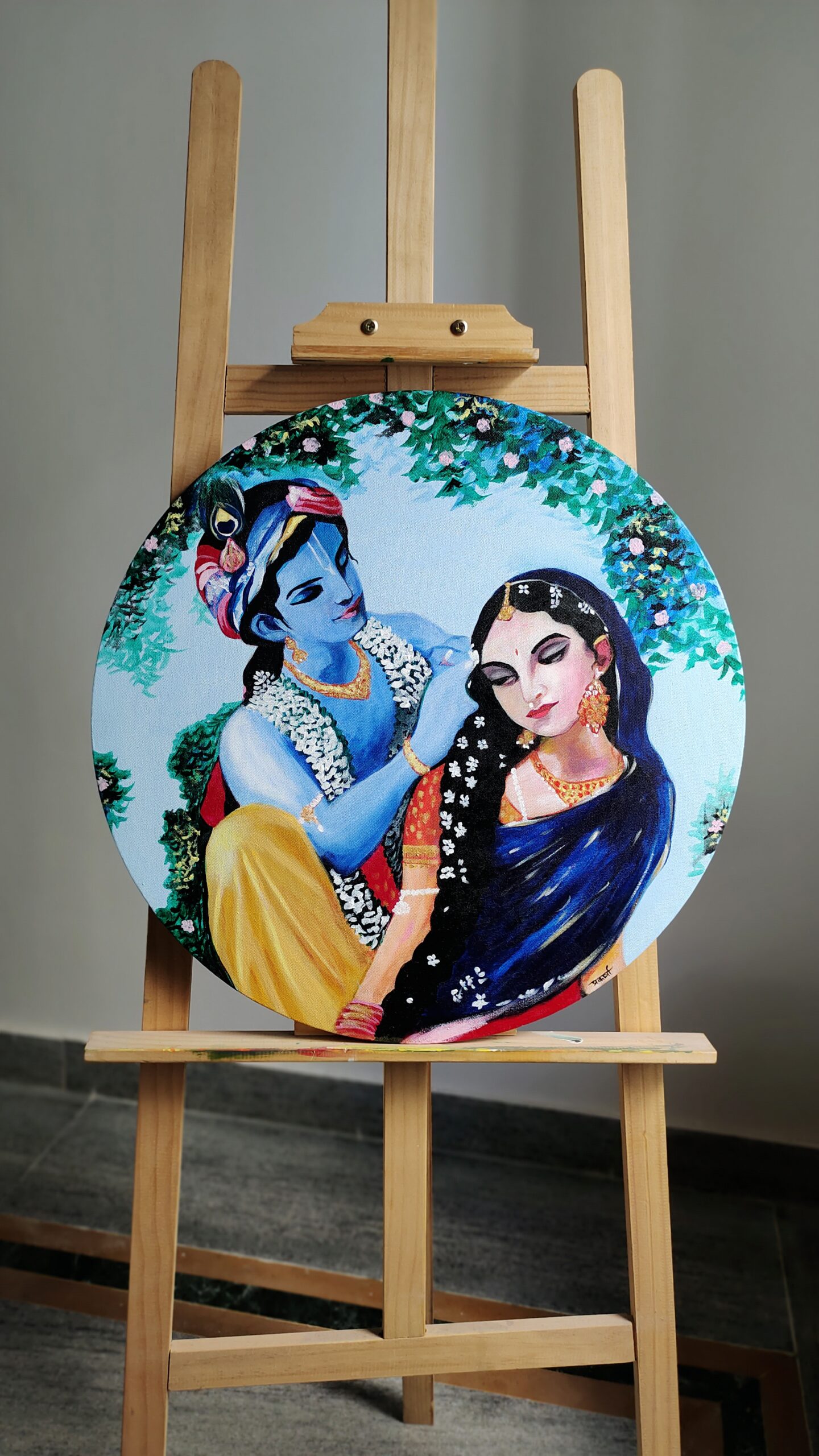Radha Krishna Acrylic Handmade Painting
One of the most revered divine pairs in Hinduism, Radha and Krishna represent the ideal of unending love. Not only is their bond passionate, but it also profoundly represents the soul’s longing for oneness with the divine. Examining Radha and Krishna’s mythological, spiritual, and cultural significance is necessary to comprehend them.
One of the main gods of Hinduism, Vishnu, took on the form of Krishna. The epic Mahabharata and the Bhagavata Purana tell mostly his story. Krishna, who was born into the Yadava tribe, had a life filled with wonders, starting when he was a playful cowherd in the village of Vrindavan, where he performed many miracles and showed signs of divinity.
Even though Radha isn’t addressed much in the major books like the Mahabharata, she plays a major role in the Krishna legends found in later writings like the Bhagavata Purana and Jayadeva’s Gita Govinda. One common description of Radha is that she is the most loyal of the gopis, or cowherd girls, who are mesmerized by the holiness and charm of Krishna. In these stories, the deep love and longing for God that the soul has for God is symbolized by Radha’s love for Krishna.
Many people see the tale of Radha and Krishna’s love as an allegory. Whereas Krishna stands for the ultimate soul (Paramatman or God), Radha signifies the particular soul (atman). Their bond is a metaphor for the soul’s spiritual path towards divinity. Radha’s longing and sense of separation are a reflection of the soul’s efforts to become one with the divine.
Radha embodies complete submission and unselfish love in her devotion. The Bhakti movement, a devotional movement that stresses loving devotion to God, is centered around this theme. Bhakti poets frequently expressed their own yearning for spiritual communion by using the metaphor of Radha’s longing for Krishna.
Over the ages, the devotion to Radha and Krishna has influenced innumerable pieces of music, poetry, and art. Radha Krishna worship had a boom in popularity throughout the Bhakti movement of medieval India, which encouraged individual devotion to a deity. Many songs were written by poets like Surdas and Mirabai, who expressed their intense love for Krishna and desire for unification with him.
Jayadeva’s Gita Govinda, written in the 12th century, celebrates Radha and Krishna’s relationship as the pinnacle of divine love. The religious activities surrounding Krishna and Vaishnavism have been greatly impacted by this work.
Classical Indian dance traditions such as Bharatanatyam and Kathak often feature themes from the Rasa Lila dance, in which Krishna is shown dancing with Radha and the gopis. These renditions frequently portray Krishna’s divine pastime, or lila, which encapsulates his early adventures and his bond with Radha.
The narrative of Radha and Krishna’s love is also shown in the exquisite miniature paintings of Rajasthan, where painters have skillfully rendered images from Vrindavan’s pastoral settings as well as their divine play. In addition to being religious objects, these artistic representations also function as cultural artifacts, illustrating the profound respect that Indian society has for Radha and Krishna.
There are shrines to Radha and Krishna all over India and other countries. Notable places of worship with elaborate rituals and festivities include the Banke Bihari Temple in Vrindavan, the Radha Raman Temple, and the ISKCON temples, particularly during festivals like Janmashtami (Krishna’s birthday) and Radhashtami (Radha’s birthday).
The location of their supposed divine pastimes, Vrindavan, is a popular pilgrimage destination. The town is the seat of Radha Krishna worship and is scattered with temples. Around the globe, devotees travel to Vrindavan to immerse themselves in the hallowed atmosphere that is connected to the holy couple’s love.
Holi and the Rasa Lila celebrations are very important. Radha and Krishna’s playful and loving characteristics are celebrated with music, dance, and color at these festivities. Holi, the celebration of colors, is particularly linked to Krishna’s joking color-throwing at Radha and the gopis, which stands for happiness, love, and the union of the soul with God.
ISKCON (International Society for Krishna Consciousness) is a devotee worshiping Radha and Krishna. The movement, which has a large international following, encourages repeating the Hare Krishna mantra, which is thought to evoke Radha and Krishna’s presence and strengthen believers’ relationship with them.







Reviews
There are no reviews yet.